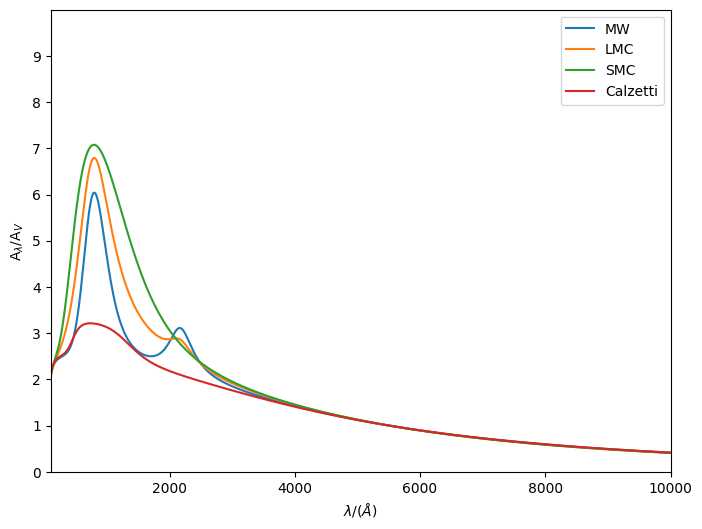Dust Attenuation Curves¶
We implement a whole suite of different attenuation curves in synthesizer, including the following:
PowerLaw: A power-law attenuation curve.Calzetti2000: The Calzetti (Calzetti et al. 2000) attenuation curve (with an optional UV bump from Noll et al. 2009).MWN18: A Milky Way attenuation curve, defined in Narayanan et al. 2018.GrainsWD01: A dust grain attenuation curve from Weingarter and Draine 2001 with models for the Milky Way, LMC, and SMC (and more defined in WD01).ParametricLi08: A parametric and empirically derived attenuation curve implemented in Li et al. 2008, including parameters from Markov et al. 2023 and Markov et al. 2024 extending it to \(z=12\).
These attenuation curves can be instantiated directly, or attached to an EmissionModel to be used in the generation of complex spectra from a galaxy or galaxy component.
Each model has unique arguments required at instantiation, but all have the same base methods, such as get_transmission (which requires an optical depth (tau_v) and a wavelength array). Below, we show how to instantiate each of these models and plot their transmission and attenuation curves.
We first define a wavelength array up front:
[1]:
import numpy as np
from unyt import Angstrom
lams = np.logspace(2, 4, 1000) * Angstrom
PowerLaw¶
A PowerLaw only requires a slope to be defined. We can then use the in-built methods, e.g. get_transmission, to return the transmission over our wavelength array values.
[2]:
from synthesizer.emission_models.attenuation import PowerLaw
power_law = PowerLaw(-1.0)
pl_trans = power_law.get_transmission(0.33, lams)
Below we plot the transmission and attenuation curves.
[3]:
power_law.plot_transmission(0.33, lams, show=True)
power_law.plot_attenuation(lams, show=True)
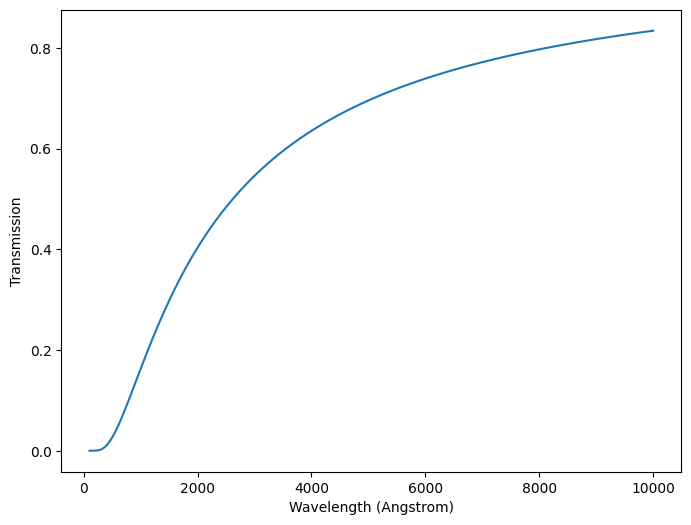
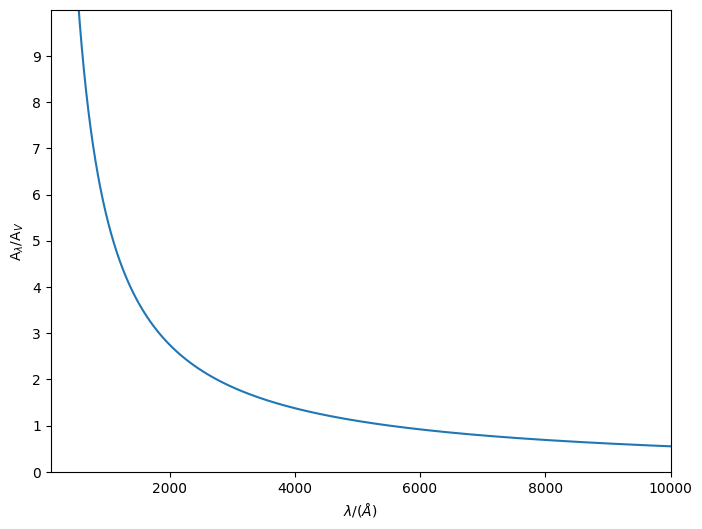
[3]:
(<Figure size 800x600 with 1 Axes>,
<Axes: xlabel='$\\lambda/(\\AA)$', ylabel='A$_{\\lambda}/$A$_{V}$'>)
Calzetti2000¶
The Calzetti2000 model requires a slope (slope), central wavelength of the UV bump (cent_lam), amplitude of the UV bump (ampl), and the FWHM of the UV bump (gamma). These default to 0.0, 0.2175 microns, 0, and 0.035, respectively. We plot the transmission curve both with the defaults and a non-zero bump amplitude.
[4]:
from synthesizer.emission_models.attenuation import Calzetti2000
no_bump = Calzetti2000()
with_bump = Calzetti2000(ampl=10.0)
fig, ax = no_bump.plot_attenuation(lams, show=False, label="No UV bump")
_, _ = with_bump.plot_attenuation(
lams, fig=fig, ax=ax, show=True, label="With UV bump"
)
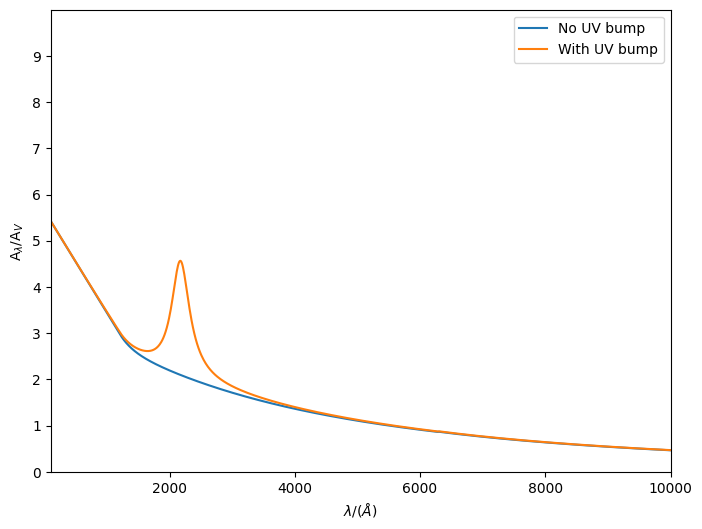
MWN18¶
The MWN18 model loads a data file included with synthesizer; as such, it requires no arguments.
[5]:
from synthesizer.emission_models.attenuation import MWN18
mwn18 = MWN18()
_, _ = mwn18.plot_attenuation(lams, show=True)

GrainsWD01¶
GrainsWD01 requires the model to be defined (either 'MW', 'LMC', or 'SMC'), and uses the dust_extinction module to load the appropriate model.
[6]:
from synthesizer.emission_models.attenuation import GrainsWD01
mw = GrainsWD01("MW")
smc = GrainsWD01("SMC")
lmc = GrainsWD01("LMC")
fig, ax = mw.plot_attenuation(lams, show=False, label="MW")
_, _ = smc.plot_attenuation(lams, fig=fig, ax=ax, show=False, label="SMC")
_, _ = lmc.plot_attenuation(lams, fig=fig, ax=ax, show=True, label="LMC")
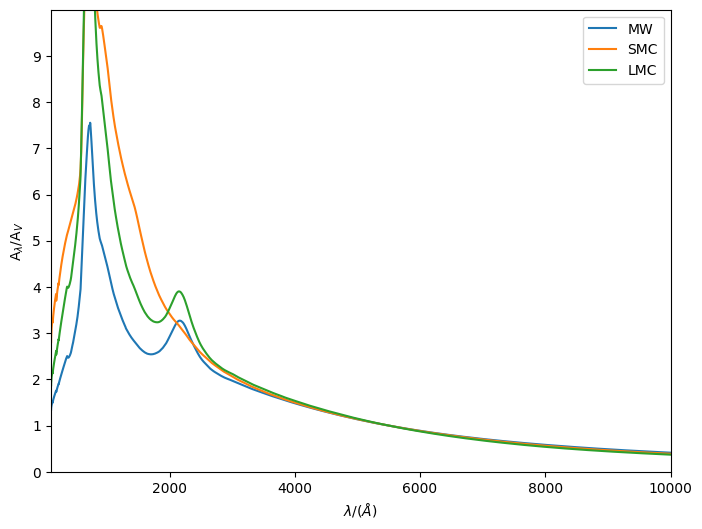
ParametricLi08¶
The ParametricLi08 model requires the UV slope (UV_slope, default 1.0), the optical to Near Infrared slope (OPT_NIR_slope, default 1.0), the Far UV slope (FUV_slope, default 1.0), and a dimensionless parameter between 0 and 1 controlling the strength of the UV bump (bump, default 0.0). Alternatively, a model string can be passed to adopt a preset model (possible values: "MW", "LMC", "SMC", or Calzetti).
[7]:
from synthesizer.emission_models.attenuation import ParametricLi08
mw_li08 = ParametricLi08(model="MW")
lmc_li08 = ParametricLi08(model="LMC")
smc_li08 = ParametricLi08(model="SMC")
calz_li08 = ParametricLi08(model="Calzetti")
fig, ax = mw_li08.plot_attenuation(lams, show=False, label="MW")
_, _ = lmc_li08.plot_attenuation(lams, fig=fig, ax=ax, show=False, label="LMC")
_, _ = smc_li08.plot_attenuation(lams, fig=fig, ax=ax, show=False, label="SMC")
_, _ = calz_li08.plot_attenuation(
lams, fig=fig, ax=ax, show=True, label="Calzetti"
)
